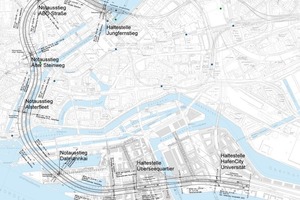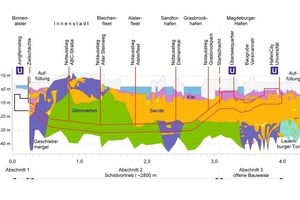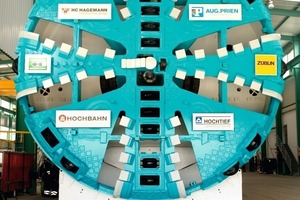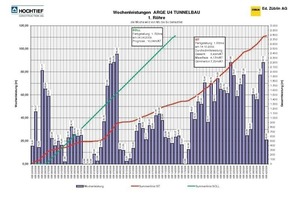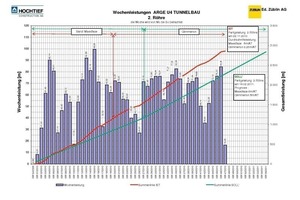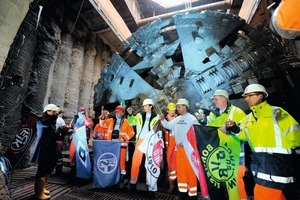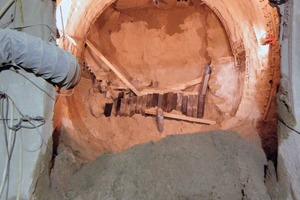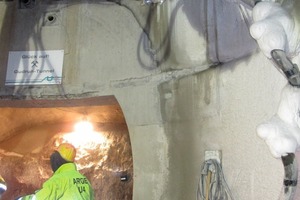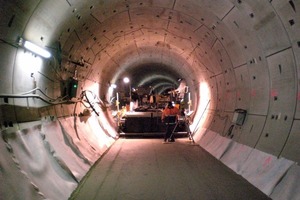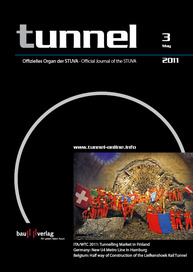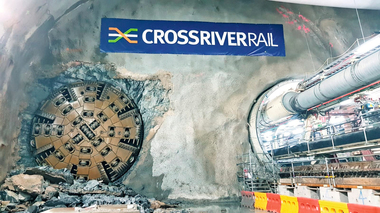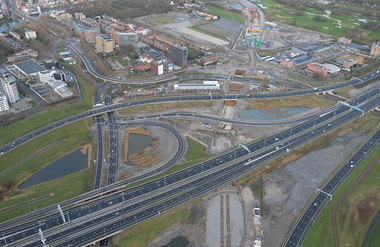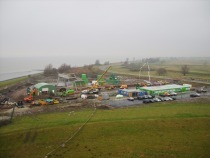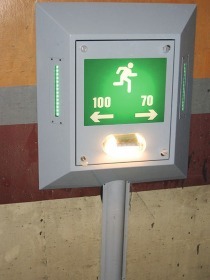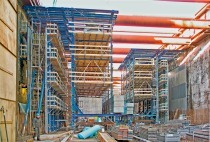New U4 Metro Line in Hamburg
Europe’s biggest urban development project, the HafenCity, is to be linked with the Hamburg transit network by the U4 metro line, which is in the process of being constructed. In a few years around 50,000 people will live and work here. The report provides an overview of the overall project, explains the shield drive and relates to current developments.
1 Overview of complete Project
The Hamburg Hochbahn AG as the future operator of the line commissioned the U4 HafenCity JV, consisting of Hochtief Solutions AG, Ed. Züblin AG, Aug. Prien Bauunternehmung GmbH & Co. KG and HC Hagemann construction group GmbH & Co. KG to undertake the roughwork at a cost of some 200 mill. euros.
The approx. 4 km long Metro line is being completed in 3 sections (Fig. 1). In the central urban area the route is to be integrated in the existing network at the Jungfernstieg stop. The tracks there that have been left unused since the U2 was opened back in 1973 are to be commissioned for the U4. During construction the U2 platforms will be developed to cope to comply with the needs of the disabled and the stop modernised.
For the arrival of the shield 2 target shafts are to be secured at the stop by means of overlapping piling and sunk to a depth of 24 m at the Jungfernstieg. Furthermore old anchors securing the original U2 construction pit had to be removed prior to the arrival of the shield by means of drilling operations.
The gap between the Jungfernstieg stop and the completed tunnel tubes was completed by mining means through freezing the subsoil.
In the HafenCity (construction section 3) the 2 new stops Überseequartier and HafenCity-University are being set up. It was possible to build the roughly 1 km long section by means of cut-and-cover in still undeveloped terrain. The construction pits were largely erected using diaphragm walls with underwater concrete base. A sheet piling wall was used for securing the Magdeburger Hafen crossing for the running tunnel between the stops.
The roughwork operations for the running tunnel as well as the stops have largely been completed. Since autumn 2010 work on the internal furnishings as well as technical equipment has been in progress.
The two U4 tunnel tubes (construction section 2) were excavated one after the other using a shield drive from the HafenCity to the Jungfernstieg. The distance between the access shaft at the Überseequartier Station and the target shafts at the Jungfernstieg amounts to some 2.8 km. The bores pass through alternating soil formations such as sands carrying water, gravels, boulder clay, local organic soft layers and in addition mica silt and mica clay (Fig. 2) over a length of 1.9 km in the central section. Altogether around 190,000 m³ of soil was removed.
In this section, 4 up to 40 m deep emergency exit shafts with cross-passages between the tunnel bores were required at roughly 600 m gaps as well as an additional cross-passage in the form of an escapeway connection.
2 Shield Drive
The Mix-Shield S-440 (Fig. 3) was devised in close cooperation between the JV and Herrenknecht according to the project parameters for driving the 2 main tunnel bores. Thus for instance the ballasted base segment to reduce the risk of clogging was catered for and the rock crusher designed in such a manner that it was capable of crushing boulders with an edge length of up to 50 cm without any problem.
On-site assembly proceeded without any hitches so it was possible to inaugurate the shield and tunnel and also commence the drive at the end of May 2009. The people of Hamburg showed great interest as the shield machine was given the name V.E.R.A. (Von der Elbe Richtung Alster) and the tunnel provided with the name of the tunnel patron “Inga” Unger-Freytag in accordance with established tradition.
The performances provided by man and machine were essentially in accordance with requirements and were in accordance with the timetable following a successful “flying start-up”. However as the proportion of clay increased in the cross-section difficulties cropped up. The combination of a high clogging potential and a low dispersion propensity of the Hamburg mica clay confronted those involved with enormous challenges.Furthermore the conditions for compressed air accesses turned out to be more difficult than expected. As a result an average rate of advance amounting to 5.5 m per working day was attained over the first half of the first bore instead of the intended 10 m (Fig. 4).
The TBM could first be optimised for a several day long compressed air access after the mica clay covered the entire surface area in such a way that the average rate of advance for the second half of the first bore rose to 7.7 m per working day.
The first breakthrough at the Jungfernstieg ultimately took place in mid-October 2009 with an extremely high degree of accuracy. Disassembly at the Jungfernstieg and reassembly at HafenCity then took place without any problems in collaboration between the JV and Herrenknecht up until the end of the year. This phase was also used intensively for conversion and optimisation operations so that V.E.R.A. was better prepared to cope with the anticipated challenges.
The second tunnel name-giving ceremony with subsequent “flying start-up” took place at the beginning of January 2010 in spite of double-digit minus temperatures. It was soon possible to attain a continuous drive and a high performance rate (Fig. 5). The optimisations functioned; the team was well-versed and finally a little bit of luck entered the picture. For instance far fewer boulders were encountered than during the initial shield drive and suitable positions for applying compressed air for removing them could be found quickly.
Over the first half of the second bore – roughly split up into the geological mixed-face conditions – an average rate of advance amounting to 8 m per working day was attained. Over the second half of the second bore – mainly in mica clay – this figure was hiked up to reach 9.25 m per working day. As a result the Jungfernstieg was already reached by the end of November 2010 for the second time (Fig. 6). Thus compared to the first bore the time for the excavation was cut by 5 months – from 15 to 11 months.
Up until the end of 2010 V.E.R.A. was again dismantled into its individual parts and transported to the Hafen. However this time it was only to be sent back by ship to the factory at Schwanau rather than be used for further tunnelling activities in Hamburg.
3 Emergency Exits/Cross-Passages
Following what ultimately emerged to be an extremely success ful and qualitatively high-grade completion of the roughwork for the 2 main tunnels, work in 2011 is again focused on the emergency exits and especially the connections between the tunnel bores and segmental tubes linking up with the emergency exit shafts. A great deal has been accomplished; however, an ambitious programme still has to be tackled, requiring all the experience and technical know-how of those involved in the project.
3.1 Grasbrook Park Cross-Passage
The Grasbrook Park cross-passage was driven protected by a jet-grouting body in an empty diaphragm wall using a conventional drive in the NATM. This construction method was subsequently agreed on between the client and contractor on account of minor problems relating to the originally scheduled freezing measure, which were determined and could not be solved. Unfortunately the body of the jet-grouting was partially incomplete for unknown reasons, which led to considerable complications during the driving operations (Fig. 7). Thanks to well-founded experience and the skill of the staff it was however ultimately possible to master all challenges, drive the cross-passage and line it with an in situ concrete shell. Only the segments for the second tube have still to be broken through and the related temporary structure linked to them concreted.
3.2 Dalmannkai and Alsterfleet Emergency Exits
The roughwork for the shaft structure for the Dalmannkai emergency exit has been completed apart from the ceiling. Currently the connecting tunnels between the shaft and the segmental tubes are being driven protected by freezing (Fig. 8). Apart from the construction technology a special challenge must be mentioned here: dealing with local residents. High-quality buildings are located around the emergency exit.
After completion of the tunnels assembly of the stairways and stairheads in the shaft – fabricated parts are used here – has to be tackled along with installing the lift, concreting the shaft ceiling and finally completing the exit structure close to the surface.
Furthermore the connecting tunnels between the shaft and the segmental tubes are also produced protected by freezing at the Alsterfleet emergency exit. The programme that has to be tackled is more or less identical with the one applied for the Dalmannkai emergency exit. However the exit structure has not to be produced as it has already been completed.
3.3 Alter Steinweg and ABC-Straße Emergency Exits
In the case of the Alter Steinweg and ABC-Straße emergency exits the connecting structures between the shaft and the segmental tubes in each case consist of a longitudinal heading running parallel to the main tunnels and a cross-passage connected to it. Here work has progressed to such an extent that only the cross-passage section for the second tube has to be completed. Afterwards the shaft has to be lined and the ceiling produced. The exit structures have already been completed.
4 Tunnel Lining
Lining the tunnel is forging ahead at full speed parallel to the construction activities at the emergency exits and cross-passages.These can roughly be divided up into the drainage, floor and edge beams still to be completed by the JV as well as other jobs concerning track construction as well as electric and signal technology awarded by the Hochbahn to other contractors.
4.1 Drainage, Floor and Edge Beams
Drainage of the segmental tunnels is carried out by a slotted plastic pipeline laid in the floor, which is located below a filter gravel bed. Inspection shafts are foreseen at regular intervals. A textile material is employed for separating the segments. An in situ concrete layer is first of all laid on the filter gravel, which essentially corresponds to a hydraulic binding layer. Finally a road finisher is employed to install a layer of roller compacted concrete (Fig. 9), which forms the basis for building the track.
The edge beams completed in in situ concrete, which are unreinforced, represents the final task to be completed by the JV. Later on they will be used as escapeways in case of an emergency.
4.2 Track Construction, Electric and Signal Technology
Work on the tracks in the 2 tunnel bores will commence in autumn 2011 and supplied completely via the former starting shaft for the shield driving machine. For this purpose during the current roughwork stage, 2 track cons truction shafts are being produced, through which the entire material is transported into the tunnel bores.
First of all ballast cushioning mats for reducing noise and vibration are installed in part-sections; then dumpers and excavators are employed to install track ballast. Salt-impregnated pinewood sleepers are then placed on the ballast by conventional means, upon which the tracks with rail lengths of up to 15 m are assembled.
The cable ducts are laid from the completed track and subsequently fitted out with the electric and signal cables. The contact rails are installed and connected at the sides of the tracks and the signals, lighting and working sockets attached to the segments.
5 Summary
The new construction of the U4 to connect the HafenCity to Hamburg’s existing public transportation system in infrastructural terms required the utmost effort on the part of those involved and still calls fortheir complete involvement for what still remains to be tackled. Diverse challenges were mastered and accomplished both contractually and financially on schedule in contrast to many other current or past projects. This only turned out to be possible because all those involved displayed great interest in developing and consolidating a positive approach to construction marked by mutual respect, trust and fairness. Against this background, it can be assumed that the tasks remaining to be accomplished will be tackled just as successfully and to the satisfaction of all concerned so that the U4 can become operational towards the end of 2012.
The new U4 metro line in Hamburg represents an important factor for the development of the district and the life quality of its inhabitants. It will connect the HafenCity with the city centre and the main station and at the same time provides the prerequisite for the “leap across the Elbe”, a direct, efficient transport link for the main growth axis in the south of the north German metropolis.

